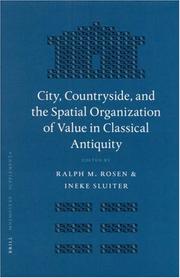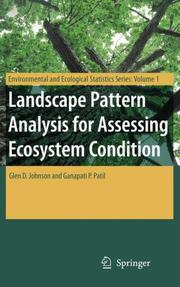| Listing 1 - 3 of 3 |
Sort by
|
Book
ISBN: 1280624779 9786610624775 1402040962 Year: 2006 Volume: v. 5 Publisher: Dordrecht : Springer,
Abstract | Keywords | Export | Availability | Bookmark
 Loading...
Loading...Choose an application
- Reference Manager
- EndNote
- RefWorks (Direct export to RefWorks)
This book seeks to contribute to theoretical advances, analytical approaches and applied studies in the broader inter-disciplinary field of contemporary landscape transformation research. The purpose of the book is to tie together various perspectives, insights and constructions pertaining to contemporary landscapes and landscape representations from different theoretical and methodological positions as well as from diverse geographical and historical contexts in order to elucidate and illustrate processes of cultural transformation inscribed in space. The unifying theme, as well as the main goal and prospective contribution of this book, then, lies in the exploration of these developing forces and characteristics of the new cultural economy of space in the contemporary landscape(s). The primary objective of bringing together in this book geographical perspectives from various subdisciplinary fields is to examine and discuss ways in which the complexities of this newly-emerging cultural economy of space are applied on various sorts of landscapes, i.e. urban and rural landscapes, landscapes of everyday life, landscapes of tourism and recreation, postcolonial and hybrid landscapes, landscapes of economic production, landscapes of the street and of public life, "national landscapes" and so on. The overarching question, thus, is: how do these processes work in different geographical contexts and contribute to place and landscape creation? Our intention is to create a space for the development of landscape discourse(s) that accommodate(s) both theory and empirical findings as well as methodological issues and practical applications pertaining to the contemporary landscape(s), by examining trends, structures, technologies and practices defining and articulating this new cultural economy of space. Another goal is to identify and facilitate innovative debate and engagement between geography and other sciences researching landscape(s). It is hoped that this endeavor will generate many more questions and areas of inquiry pointing to new directions currently developing in the study of landscape(s) than the questions on the basis of which this task was undertaken here in the first place.
Landscape assessment. --- Landscape changes. --- Human geography. --- Anthropo-geography --- Anthropogeography --- Geographical distribution of humans --- Social geography --- Anthropology --- Geography --- Human ecology --- Assessment, Landscape --- Environmental perception --- Landscape evaluation --- Landscape perception --- Perception, Landscape --- Land use --- Landscape protection --- Change, Landscape --- Geomorphology --- Life sciences. --- Social sciences. --- Social sciences --- Regional planning. --- Architecture. --- Life Sciences, general. --- Social Sciences, general. --- Methodology of the Social Sciences. --- Landscape/Regional and Urban Planning. --- Landscape Architecture. --- Methodology. --- Behavioral sciences --- Human sciences --- Sciences, Social --- Social science --- Social studies --- Civilization --- Biosciences --- Sciences, Life --- Science --- Architecture, Western (Western countries) --- Building design --- Buildings --- Construction --- Western architecture (Western countries) --- Art --- Building --- Regional development --- Regional planning --- State planning --- Human settlements --- Planning --- City planning --- Design and construction --- Government policy --- Urban planning. --- Landscape architecture. --- Horticultural service industry --- Landscape gardening --- Landscaping industry --- Cities and towns --- Civic planning --- Land use, Urban --- Model cities --- Redevelopment, Urban --- Slum clearance --- Town planning --- Urban design --- Urban development --- Urban planning --- Art, Municipal --- Civic improvement --- Urban policy --- Urban renewal --- Management --- Sociology --- Life Sciences. --- Society. --- Sociological Methods. --- Human Geography.

ISBN: 9004150439 9789004150430 9786611398576 1281398578 9047409183 9789047409182 9781281398574 6611398570 Year: 2006 Volume: 279 Publisher: Leiden Boston Brill
Abstract | Keywords | Export | Availability | Bookmark
 Loading...
Loading...Choose an application
- Reference Manager
- EndNote
- RefWorks (Direct export to RefWorks)
The third in a series that explores cultural and ethical values in Classical antiquity, this volume examines the dichotomy between 'city' and 'country' in ancient Greek and Roman cultures. Fourteen papers address a variety of topics on this theme, and include a variety of methodological approaches—archaeological, iconographic, literary and philosophical. The book demonstrates that, despite a common rhetoric of polarity in antiquity that tended to construct city and countryside as very distinct, oppositional categories, there was far less consistency (and far more nuance) about the ideologies felt to inhere in each.
Rural-urban relations --- Classical literature --- City and town life in literature --- Country life in literature --- Space in literature --- Relations villes-campagnes --- Littérature ancienne --- Vie urbaine dans la littérature --- Vie rurale dans la littérature --- Espace dans la littérature --- History --- Congresses. --- History and criticism --- Histoire --- Congrès --- Histoire et critique --- Landscape assessment --- Geographical perception --- Landscape in literature --- History. --- History and criticism. --- Landscapes in literature. --- Littérature ancienne --- Vie urbaine dans la littérature --- Vie rurale dans la littérature --- Espace dans la littérature --- Congrès --- Landscapes in literature --- Assessment, Landscape --- Environmental perception --- Landscape evaluation --- Landscape perception --- Perception, Landscape --- Human ecology --- Land use --- Landscape protection --- Maps, Mental --- Mental maps --- Perceptual cartography --- Perceptual maps --- Perception --- Orientation (Psychology) --- Space perception --- Rural-urban interaction --- Urban-rural interaction --- Urban-rural relations --- Sociology, Rural --- Sociology, Urban --- Landscape assessment - Greece - History. --- Landscape assessment - Rome - History. --- Geographical perception - Greece - History. --- Geographical perception - Rome - History. --- Rural-urban relations - Greece. --- Rural-urban relations - Rome. --- Landscape in literature - History and criticism. --- Classical literature - History and criticism.

ISBN: 0387376844 1441942491 9786610744947 1280744944 0387376852 Year: 2006 Publisher: New York, NY : Springer,
Abstract | Keywords | Export | Availability | Bookmark
 Loading...
Loading...Choose an application
- Reference Manager
- EndNote
- RefWorks (Direct export to RefWorks)
As we begin the 21st century, one of our greatest challenges is the preservation and remediation of ecosystem integrity. This requires monitoring and assessment over large geographic areas, repeatedly over time, and therefore cannot be practically fulfilled by field measurements alone. Remotely sensed imagery therefore plays a crucial role by its ability to monitor large spatially continuous areas. This technology increasingly provides extensive spatial-temporal data; however, the challenge is to extract meaningful environmental information from such extensive data. Landscape Pattern Analysis for Assessing Ecosystem Condition presents a new method for assessing spatial pattern in raster land cover maps based on satellite imagery in a way that incorporates multiple pixel resolutions. This is combined with more conventional single-resolution measurements of spatial pattern and simple non-spatial land cover proportions to assess predictability of both surface water quality and ecological integrity within watersheds of the state of Pennsylvania (USA). The efficiency of remote sensing for rapidly assessing large areas is realized through the ability to explain much of the variability of field observations that took several years and many people to obtain.
Landscape ecology --- Landscape assessment --- Ecological integrity --- Landscape protection. --- Nature conservation. --- Ecosystem management. --- Biotic communities --- Ecosystems management --- Conservation of nature --- Nature --- Nature protection --- Protection of nature --- Beautification of the landscape --- Conservation of landscapes --- Conservation of scenic beauty --- Conservation of scenic resources --- Landscape --- Natural beauty conservation --- Preservation of natural scenery --- Preservation of scenic resources --- Protection of landscapes --- Protection of scenic beauty --- Protection of scenic resources --- Scenery preservation --- Ecosystem integrity --- Integrity, Ecological --- Assessment, Landscape --- Environmental perception --- Landscape evaluation --- Landscape perception --- Perception, Landscape --- Management --- Conservation --- Protection --- Life sciences. --- Geographical information systems. --- Remote sensing. --- Landscape ecology. --- Statistics. --- Ecotoxicology. --- Life Sciences. --- Landscape Ecology. --- Remote Sensing/Photogrammetry. --- Statistics for Life Sciences, Medicine, Health Sciences. --- Geographical Information Systems/Cartography. --- Environmental Monitoring/Analysis. --- Ecology --- Human ecology --- Land use --- Landscape protection --- Applied ecology --- Environmental management --- Nature conservation --- Biodiversity conservation --- Conservation of natural resources --- Conservation biology --- Endangered ecosystems --- Natural areas --- Environmental protection --- Environmentally sensitive areas --- Regional planning --- Environmental toxicology. --- Monitoring/Environmental Analysis. --- Ecotoxicology --- Pollutants --- Pollution --- Environmental health --- Toxicology --- Geographical information systems --- GIS (Information systems) --- Information storage and retrieval systems --- Statistical analysis --- Statistical data --- Statistical methods --- Statistical science --- Mathematics --- Econometrics --- Geography --- Statistics . --- Environmental monitoring. --- Biomonitoring (Ecology) --- Ecological monitoring --- Environmental quality --- Monitoring, Environmental --- Environmental engineering --- Remote-sensing imagery --- Remote sensing systems --- Remote terrain sensing --- Sensing, Remote --- Terrain sensing, Remote --- Aerial photogrammetry --- Aerospace telemetry --- Detectors --- Space optics --- Measurement --- Monitoring
| Listing 1 - 3 of 3 |
Sort by
|

 Search
Search Feedback
Feedback About UniCat
About UniCat  Help
Help News
News